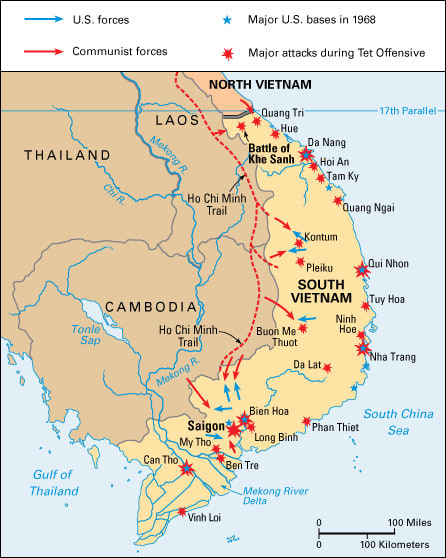Fifty years ago today, on Jan. 30, 1968, a massive battle known as the Tet Offensive began during the Vietnam War (1957-1975). In the offensive, Communist-led South Vietnamese guerrillas called Viet Cong, backed by forces from Communist North Vietnam, launched attacks against military bases and major cities in South Vietnam. United States and allied forces fought on the side of South Vietnam. The Tet Offensive was a costly military defeat for the Communist forces, but it proved to be a political victory because it turned U.S. public opinion—already sharply divided—strongly against the war. The Tet Offensive thus became the turning point in the Vietnam War.
The Tet Offensive was supposed to begin on January 31, during a truce to mark Tet, the Vietnamese New Year holiday. But some commanders mistakenly attacked on January 30 instead. Fighting erupted in numerous places around South Vietnam. It was especially fierce in South Vietnam’s capital, Saigon (now Ho Chi Minh City), and in northern Hu? city. Viet Cong forces also lay siege to an isolated U.S. Marine unit at Khe Sanh in central Vietnam. This action was intended to divert attention away from the assault on the cities.

The Tet Offensive had a number of objectives. North Vietnam and the Viet Cong hoped to incite South Vietnamese citizens to revolt against their government. Another goal was to inflict a major defeat on U.S. and South Vietnamese forces. However, the offensive’s larger purpose was to undermine the American will to fight. North Vietnam believed it could demonstrate to American war leaders that they could not win in Vietnam by military means. American war leaders had been trying to convince the American public and news media that the enemy was almost defeated. The Tet Offensive was designed to prove this statement false, and convince the United States that it should negotiate an end to the war.
Despite much heavy fighting, the Communists failed to achieve success on the battlefield or to spark a popular uprising in their favor. But the Tet Offensive did convince most Americans that the war was likely to be long and costly, with no outright victory for either side. As a result, public support for the war dropped rapidly. The controversy over U.S. policy in Vietnam contributed to U.S. President Lyndon Johnson’s decision not to run for reelection in 1968. In addition, the Tet Offensive led to the opening of negotiations that ultimately brought the Vietnam War to an end. United States troops left Vietnam in 1973, and the war ended in 1975 with a Communist victory.
On Jan. 26, 2018, the Newseum in Washington, D.C., opened an exhibit called “The Marines and Tet: The Battle That Changed the Vietnam War.” The exhibit features 20 large-format photographs from the Tet Offensive and 10 tactile versions of those photographs with touch-activated sensors that provide audio interviews. The tactile versions allow blind and low-vision visitors to experience the images through touch and sound—the first such major tactile exhibit for that purpose in the United States. The exhibit runs through July 8. The Newseum, just north of the National Mall, features interactive displays on journalism and its history. The museum’s mission is to increase public understanding of the importance of a free press and the First Amendment.
Untitled Document
Can't view the linked articles? Subscribe to World Book Online

World Book Online delivers a progressive sequence of core databases supported by supplemental
tools, such as language translation, graphic organizers, and unique Webquests. Moving from
Early World of Learning to World Book Advanced, World Book Online aligns end-users with their
appropriate learning levels. Each stand-alone site provides additional features to support the
needs of users’ specific capabilities.
The World Book Difference
World Book combines cutting-edge technology with traditional editorial excellence to produce
authoritative, trustworthy, and unbiased content. The digital content is updated in real time and
carefully curated for each learning level. Accessible 24/7, the content is available on a variety of devices.
World Book Online combines 21st-century instructional techniques with timely information.
By breaking down complex topics and using easily understandable text, World Book Online helps to
build fluency and increase comprehension. Featuring single sign-on capability, these sites are paired
with highly visual content to engage even the most reluctant reader. Our collection of resources kindles
a lifelong learning experience for every user. This adherence to clarity, currency, and accuracy makes
World Book’s digital offerings an information hub for the classroom, library, and beyond.
Image 1: South Vietnamese Army Rangers defend Saigon during the 1968 Tet Offensive. Credit: Department of Defence
Image 2: The 1968 Tet Offensive was a yearlong assault on South Vietnamese targets during the Vietnam War. Credit: WORLD BOOK map